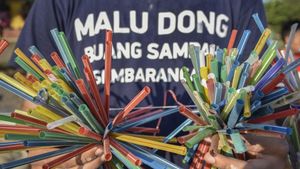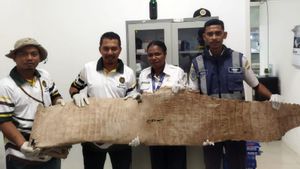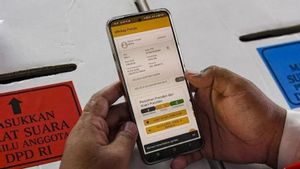JAKARTA - If there is one lesson that can be learned from the COVID-19 pandemic, perhaps it is the rapid development of the cycling lifestyle. Call it a seasonal trend. However, it's still something to be grateful for. If you look at a similar trend wave in 2012, the cycling trend at that time left many people who until today still pedaling in their daily lives. Pull back. Since when did bicycles enter Indonesia?
Environmental aspects are the most helped. Environmental activist, Anton P. Widjaya, said that the viral phenomenon from Wuhan had at least made people aware that the universe actually has the power and ability to protect our lives as humans. For cyclists, COVID-19 teaches you to enjoy more time by cycling while participating in protecting the environment.
"It is in this context that the community provides the opportunity for the natural environment to breathe, restore its carrying capacity, capacity, and increase its ecological resilience," he told VOI some time ago.
In terms of the economic cycle, the cycling trend also brings blessings. Kompas.com wrote, the demand for bicycles has increased rapidly. The domestic local bicycle manufacturer, PT Roda Maju Bahagia (RMB), which produces the Element MTB, Police Bike, Camp, Ion, and Capriolo brands, has managed to pocket about 50 percent of the sales realization of the total sales volume target that it wants to pursue this year. And this is only the fifth month.
Entry of bicycles to Indonesia
Bicycles are clearly not new to Indonesians. Bicycles have entered the archipelago since Indonesia was still called the Dutch East Indies, under Dutch colonial rule.
Achmad Sunjayadi in the book Tourism in the Dutch East Indies 1891-1942 (2019), noted that bicycles which in Dutch are called "fiets" or "wielrijder" (wheel riders) have been known since ancient times. At that time, in the 19th century, bicycles were still familiarly called Velocipede.
“An article in a newspaper published in Batavia in 1887 said the performance in Schouwburg, Batavia would entertain the sports-loving community. A wielrijder WS Maltby and skater RJ Aginton from Australia will perform, ”wrote Achmad.
During its development, velocipede began to be forgotten along with the presence of a bicycle with wind-filled rubber tires named rijwiel in 1890. On this basis, cycling became a new hobby of citizens of the world, including the Dutch East Indies.
Even so, related to exactly when the bike came in still requires further research. However, bicycles have been estimated to have entered the Dutch East Indies around the 1890s.
"Bicycles or wind trains in Malay according to The Straits Independent and Penang Chronicle (21 April 1894) were introduced in Asahan, North Sumatra by a European who worked as a manager of a tobacco company in late 1894."
There are also those who consider the presence of bicycles to have existed before 1894. This is evidenced by the news in the Java Bode newspaper (1890). In the news, an unknown man traveled from Batavia to Buitenzorg (Bogor) on Easter Day, April 7, 1890.
Most likely, a rider was European (Dutch). The proof lies in the destination of the cyclist inscribed in the newspaper: een klein gedeelte van ons schoon insulinde te doorkruisen (across a small part of our beautiful insulinde).
Bicycles as prestigeOwnership of bicycles in the Dutch East Indies at that time was still limited. Only certain groups, such as colonial officials, aristocrats, missionaries, and wealthy merchants, owned bicycles. Ownership of bicycles expanded right during the quiet period of World War I. At that time, trade offices from various European countries settled in the Dutch East Indies.
They marketed bicycles in big cities, such as Batavia, Bandung, Semarang, Surabaya, Medan, Banjarmasin and Makassar. This is known through a number of enamel advertisements - advertisements made of enamel coated metal plates - from well-known brands.
"These brands, such as Fahrrad, Opel, Batavus, Gazell, and Raleigh, spread throughout Indonesia around 1930-1939. The bicycles made in Europe are sent to Indonesia using wood-fired or coal-fired ships, not using oil-fueled boats, ”writes in the book Piet Onthel (2011).
Those who became consumers of foreign-made bicycles were mostly colonial officials. The bicycle was used as a means of transportation to support the smooth administration of the colonies. Bicycles were used as an important inventory at that time.

Apart from company officials, those who used bicycles were limited to priests, nobles to wealthy merchants. “The price of a bicycle like the Gazalle, at that time was very expensive, almost the equivalent of 1 gold ounce - equivalent to IDR 25 million. Therefore, ordinary people can only afford to buy used bicycles or wait for them to come down. "
Even if there are Europeans who see native people using bicycles, they often immediately face discrimination. This description was recorded by Iksaka Banu in his short story which is summarized in the book Tea and Betrayer entitled Above the Wind Train (2019).
As a story in our writing, "The History Behind the Name Jongos: Praise in the Dark of Discrimination". It is said, there was a kind-hearted European who lent a bicycle to his assistant for daily needs. However, this action disturbed the mind of a European relative who had just arrived from outside the city.
“Now, why is your bachelor riding fielts (bicycles) and wearing European pants? It is not our group - Europeans - who will be stung by such a thing. but also the aristocratic bumiputra. For them, pantalon and shoes are the distinction between priyayi and kawula position. Don't make them feel insulted, ”wrote Iksaka.
Fortunately, when Japan came to power, racist views like the above did not exist anymore. At that time, Europeans or Indo-Europeans who previously considered themselves to be in a special position, when Japan entered, were in the lowest ranks.
Presumably, that is what makes a perfect bicycle as a popular transportation. How could I not, starting from the upper class to the lower class seemed comfortable using a bicycle. Uniquely, this form can be seen by a wide audience in the lyrics of the song composed by Iwan Fals, Guru Oemar Bakri (1981):
The moped on the potholes,
Always been like that since the Japanese era,
He was surprised when he was about to enter the gate,
Many policemen carry fierce-faced weapons.
The English, Chinese, Japanese, Arabic, and French versions are automatically generated by the AI. So there may still be inaccuracies in translating, please always see Indonesian as our main language. (system supported by DigitalSiber.id)









